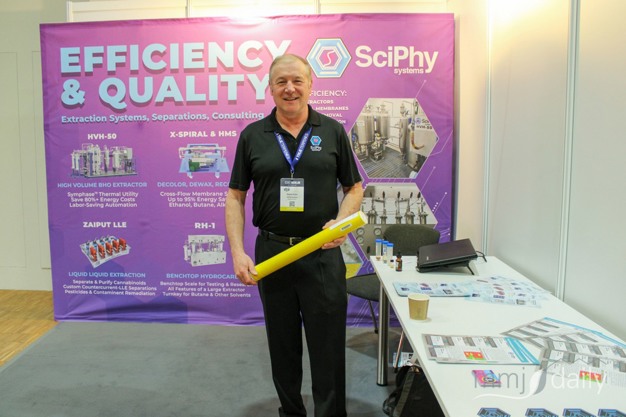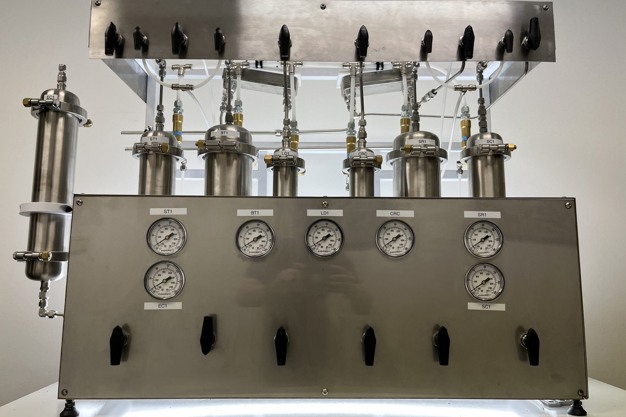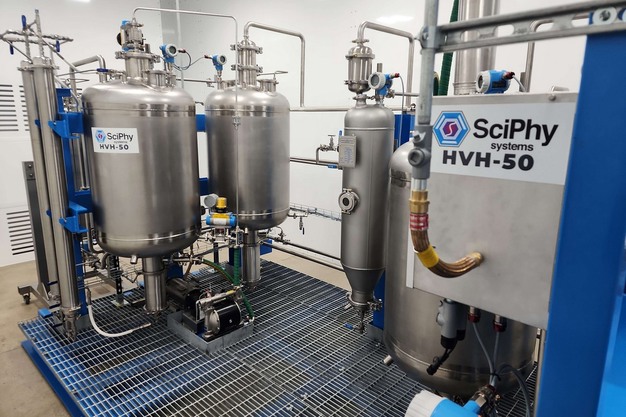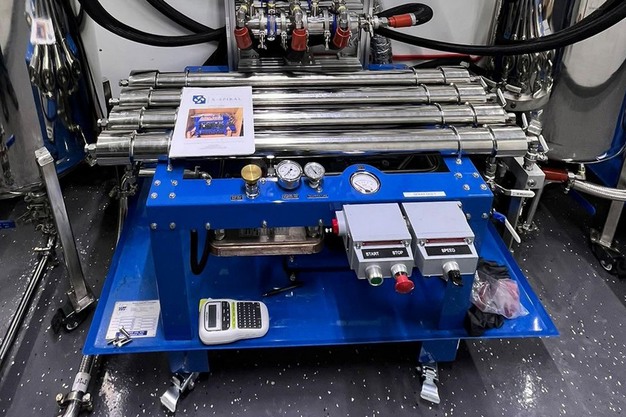"Every legalized cannabis market follows a predictable trend. Flower dominates nearly 100% of a new market in the beginning, until the first fall harvest. The resulting oversupply inevitably causes flower prices to crash, and they never fully recover. At that point, the only way to be profitable is by extracting essential oils and making vapes or edible products," says Steve Fuhr of SciPhy Systems. The company specializes in extraction equipment. Steve explains that in most markets, concentrates and edibles take over half the market within 3 years. "But it's not just a market dynamic, it's a function of customer education and preferences. The more customers experience the robust flavors and potency of concentrates or the ease of consuming edibles, the more they demand them."
Steve Fuhr at ICBC Berlin
"Not easy to learn"
According to Steve, extraction is not easy to learn. "In a legal, regulated cannabis market, being a successful extraction lab operation requires a wide range of skills, starting with understanding how to select the correct zoned land and classified building. You can be the best extractor on earth, but if the parcel you picked needs a Change of Use Permit, or the building needs to be reclassified, you can spend 2 years battling the Building Department, only to lose while you run out of money. And if you do get permitted, you have to expertly navigate the complex web of Building Code that applies to labs. So, it starts with being a Land Developer and Master Builder."
"Then you need to develop a keen understanding of the different solvent types; what effects polar versus non-polar solvents have, how membrane technology and nanofiltration work, when to distill and when not to, minimizing decarboxylation losses, and how to do chemical separations using complex systems like distillation and chromatography that may involve a range of other solvent and media," Steve adds. "Add to that your own in-house testing, which means one also needs to become an Industrial Chemist."
Next, you need to know how to identify and procure equipment that performs all this work to cGMP standards, Steve says. "The equipment needs to be arranged in a way that optimizes workflow and efficiencies of scale. Then you have to build the lab and staff to go through the cGMP certification process. That means being an expert Project Manager, a Good Manufacturing Processes guru, and of course, forever a Human Resource Manager."
"Last but not least, you have to make a final product, test it, package it, and sell it with eyes on keeping the costs as low as possible, so hopefully, you can make a profit as competition squeezes margins as the market demand shifts under your feet constantly. For that, you (or your team) need to be skilled Process Engineers, Co-Packers, Accountants, Market Research Specialists, and very good Salespeople."
Considerations
While it may be a long journey to become a successful extraction lab, the demand for extracts continues to grow. So for the companies wanting to take on the challenge, what are the key factors to consider when choosing the equipment? "The first factor in buying extraction equipment is knowing what products you want to make," Steve says. "If you use ethanol or CO2 for solvents, you are only making THC distillate for vape carts or edibles. Rosin presses only make rosin, and hash machines only make hash. On the other hand, hydrocarbons can make dabbable waxes, shatters, sugars, live resin, and the famed Diamonds & Sauce, all of which are acidic forms of the cannabinoid THC-A. You can decarboxylate your THC-A to make the THC distillate too."
The second major consideration is scale. "Making one liter of THC crude concentrate takes about 20 lbs. of biomass. Doing that in a 1-pound-per-run BHO extractor costs over $1,000 not including the cost of biomass and 20 hours of labor. A 50-pound-per-run machine makes that same liter for $35 in 5 minutes."
The final big consideration is automation. "Take any machine or process, automate it, and it will double the capital investment upfront to buy the equipment, if not triple it. However, automation is not a Cap-X question; it's an Op-X question. Ask yourself how many months or years away is the Return On Investment for any automation. If the ROI is measured in years, it might not be worth doing right now. If the ROI is measured in months or days, it would be foolish not to make that investment immediately."
Different technologies
The main focus of SciPhy Systems is hydrocarbon extraction and post-processing purifications to a (cGMP) pharmaceutical grade. "We also work with ethanol systems, but this is fast becoming a relic of the hemp-CBD extraction phase of our industry. It's also a much more cost-effective process than CO2, which also uses ethanol in its process. The ethanol extraction process destroys high-value terpenes that hydrocarbons preserve. It's worth noting a liter of terpenes is now worth over 20 times more than THC concentrate," Steve says. "Many are unaware that light hydrocarbons like butane are medical-grade solvents with Generally Recognized as Safe (GRAS) status through the FDA. This is not the kind of butane you use in your backyard cooking grill. It's the kind pharmacists use to drive asthma inhalers. It's that safe."
The company's post-purification systems are centered around a range of membrane systems that reduce or eliminate the need for extreme heat or cold. "Thus we're preserving valuable terpenes and acid cannabinoids like THC-A. Membranes can do everything from removing solvents, fats, or unwanted colors, to remediating metals or pesticides. They also separate cannabinoids, like fractioning THC from CBD. We are even working on perfecting a way to avoid the costly distillation process using membranes too."
Saving energy and money
Steve explains that in addition to membranes allowing for faster, more efficient production of refined cannabis oils, because they operate at near ambient temperatures, they save major amounts of energy compared to more typical systems.
"X-Spiral membranes replace 3-4 systems doing different functions like solvent recovery, dewaxing, and decoloring. The biggest energy savings come from not needing to pre-chill biomass or an extraction process. This replaces older solvent recovery like Falling Film Evaporators or Rotovaps and cryo-dewaxing equipment. FFEs use high heat (~150C) and then low-temperature cooling (-20C) to separate cannabinoids from ethanol solvents. Old cryo-dewaxing systems chill tincture at ultra-low temps (-60C) to freeze out fats. X-Spiral can do recovery at near ambient temps (+25C) and dewaxing at 0-C, which saves 95% of the power normally used. It also reduces distillation needs by 33%. This is why X-Spiral can qualify for efficiency incentives that pay for 80% or more of the equipment costs," Steve says.
"Beyond the valuable efficiency rebates, we have worked with processors saving over $450,000 a year in electricity alone. In addition, they use about a quarter of the space their old equipment took up, they turn tasks that were taking 5 days into one, and they can trim labor by half or more. They also lose less product to the process, so yields go up, and at the end of the day, they make a better product that is worth more," he adds.
For more information:
SciPhy Systems
www.sciphysystems.com
